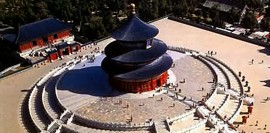 Stepping into Beijing, the Summer Palace is a wonderful place to explore, with its handsome buildings, beautiful scenery and tumultuous history. As long as the Yuan Dynasty, officials set up their private gardens in the scenic area, but Summer Palace didn't take on its present appearanc euntil the reign of Emperor Qianlong of the Qing Dynasty. He deepened the manmade lake and added buildings to serve as a "County Home" for his mother, thought it would be the Empress Dowager Cixi who would have the biggest impact on Summer Palace's appearance.
Stepping into Beijing, the Summer Palace is a wonderful place to explore, with its handsome buildings, beautiful scenery and tumultuous history. As long as the Yuan Dynasty, officials set up their private gardens in the scenic area, but Summer Palace didn't take on its present appearanc euntil the reign of Emperor Qianlong of the Qing Dynasty. He deepened the manmade lake and added buildings to serve as a "County Home" for his mother, thought it would be the Empress Dowager Cixi who would have the biggest impact on Summer Palace's appearance.
During the Second Opium War in 1860, the Summer Palace was partially destroyed. In 1886, Cixi diverted funds earmarked to build a modern Chinese navy and spent the money on endowing the Summer Palace with a marble boat-shaped pavilion and other extravagances throughout the palace. She also gave the palace its current name, Yiheyuan, which means "the Garden for Cultivating Harmony
In 1900, Western armies again unharmoniously sacked the Summer Palace, this time in retaliation for the Boxer Rebellion. Undeterrred, Cixi again rebuilt this pleasure dome which had become her fulltime residence. She died in 1908.
The Summer Palace is divided into three sections: the halls for political activities, the living quarters and religious buildings. For example, Hall of Benevolence and Longevity, Hall of Jade Rippes, Hall of Happiness and Longevity, the Long Corridor, Hall of Dispelling Clouds, Tower of Buddhist Incense, Sea of Wisdom, Hall for Listening to the Qrioles, and the Marble Boat.
Long Corridor (Chang Lang)
The Long Corridor is the longest one in all of the corridors in Chinese classical gardens. It was originally built in the 15th year of Emperor Qianlong's reign (1750) and then rebuilt in the 12th year of Emperor Guangxu's reign (1886). Covering a distance of 728 meters with its 273 sections, the Corridor starts from Inviting the Moon Gate in the east and ends at Shizhang Pavilion in the west. On its beams are more than 8,000 colorful paintings depicting stories from Chinese classical novels, folk tales, landscapes as well as flora and fauna. Four pavilions, "Mesmerizing Scenery", "Harmonizing with the Lake", "Autumn Water" and "Clear and Carefree", with octahedral structures and double eaves, were built intermittently along the corridor.
Hall for Listening to Orioles (Tingli Guan)
Hall for Listening to Orioles, called Tingli Guan in Chinese, is a theatre with two-story stage that initially built by Emperor Qianlong for his mother to watch operas. It was named the "Hall for Listening to Orioles" because in old times, people often compared beautiful voices to the singing of orioles. Before the completion of the Great Stage in the Garden of Virtue and Harmony, the Empress Dowager often watched operas and held banquets here. Now, the hall serves as a restaurant specializing in imperial court cuisine and has become very famous for having received more than one hundred foreign leaders.


 About Beijing
About Beijing 


